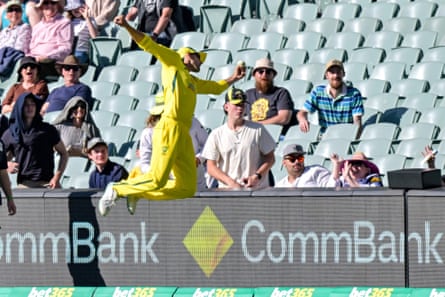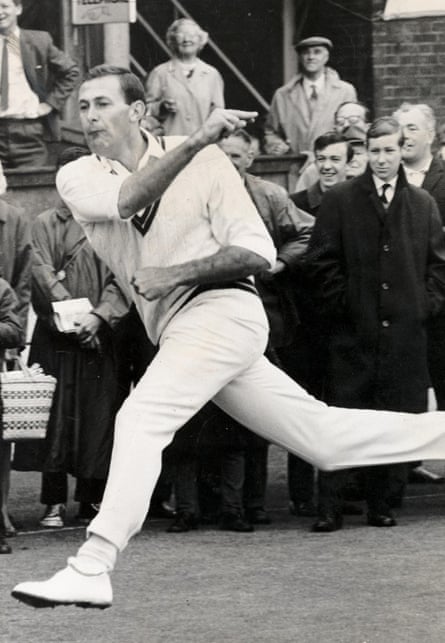Rob Key has devoted his lifestyles to cricket. The present managing director of the boys’s sport in England performed professionally for the most efficient a part of twenty years and scored nearly 20,000 top notch runs. He beloved batting and was once excellent at it, but he spent the vast majority of his time as a cricketer doing one thing he loathed. He hated fielding.
“The fear of letting people down is constant, as is knowing you can’t do anything about it,” he writes in his memoir Oi, Key. In a bankruptcy entitled The Grind, Key describes how he by no means grew bored with the a part of the sport he actually beloved – scoring runs – however says the “dread” of fielding was once at all times with him. Post-retirement he stated wryly: “Fielding is as close as a human gets to being a dog.”
Key’s not up to favorable emotions in opposition to fielding are mirrored within the perspectives of many cricketers, each newbie {and professional}. It’s a interest that a complete self-discipline of the sport is hated by means of massive swathes of the individuals who play it. For them, the 3rd component is cricket’s 3rd wheel – a chore to be continued sooner than it is their flip to have a move at the great things.
Fielding can also be desolate, relentless, sapping of thoughts and frame. In the timed or limited-overs suits in most cases performed by means of amateurs, there may be succour to be present in realizing that it cannot move on eternally. Not so in top notch cricket, the place groups can spend days within the box; consultation after consultation, gradual loss of life by means of one thousand deliveries.
For Paul Collingwood, in all probability England’s largest ever fielder, there may be nonetheless enjoyment to be taken from the ones days within the grime. A flaxen-haired jaguar prowling at backward level, he was once by no means happier than when hurling himself at a cricket ball, straining each sinew to prevent a shot or take a catch.
“It’s all part of it for me,” he says. “The deep satisfaction you get when you win Test matches means so much more when you’ve been through those never-ending days, the sessions that burn with proper fatigue, your whole body aching, legs like lead. I guess that’s what you play the game for. Those hard days give the other days more meaning. You’ve got to get through ’em, get the dark humor out.”
Nevertheless, Collingwood admits that even he might have struggled to summon gallows humor if he had been playing in the 1999 Durban Test between South Africa and England. Nasser Hussain’s side spent 1,112 minutes (just shy of 19 hours, spanning three days of play) in the field watching Gary Kirsten compile 275 in 878 minutes, the second-longest Test innings on record. Such stints in the field are incomprehensible to the amateur player, who will never appreciate the erosion of the soul brought about by session after session of torment and toil. You could argue the biggest chasm between the professional and amateur game is not batting or bowling, but in the field.
Skills with bat and ball have evolved markedly in the modern era, but of the three disciplines it is fielding that has seen the biggest transformation. The athleticism we see today, largely as a result of the proliferation of short-form cricket, is unrecognizable from 10 or 20 years ago.
The recent T20 World Cup in Australia was the latest tournament to show off acrobatic feats from unlikely sources – Ireland player Barry McCarthy pulled off a memorable boundary save that seemed to defy gravity, bringing gasps from the commentators and spontaneous applause from the Australian dug out. When burly fast bowlers named Barry are displaying the gymnastic flair of a prima ballerina, it is an indication of just how far fielding has come. Leaps and bounds.
During the ill-timed Australia v England ODI series that began just days after the T20 World Cup final, Ashton Agar (another bowler) left the cricketing world open mouthed with a piece of fielding at the Adelaide Oval that was immediately clipped up and shared online with debate swirling as to whether it was the greatest piece of fielding ever. It has to be seen to be believed.

“It’s incredible what people can achieve when they practice,” says Collingwood. “T20 triggered a real momentum shift in fielding and the attitudes around it. You know, there’s a lot of money to be made. You’ve got to be a good fielder to get anywhere near a side these days.”
It wasn’t always this way. Surviving footage of cricket’s early years tends to show a somewhat gentlemanly approach to fielding, whereby a light trot is the most effort given – diving or haring after the ball was seemingly not the done thing. In these highlights reels, fielders often resemble extras in a silent movie.
However, there are accounts of superlative fielders from the game’s formative years. The Reverend Vernon Royle was one. A middle-order batsman for Lancashire who played a solitary Test match for England against Australia in 1879, Royle was said to be ambidextrous, lightning fast in the covers, and in possession of a powerful throwing arm. Gilbert Jessop, who made the first of his 18 Test appearances for England in 1899, earned the nickname “The Croucher” for his hunched technique at the crease but was also praised for his fielding. Jessop’s obituary in Wisden noted that his skills in the field were as “phenomenal” as his batting.
Australia had Clarence Everard “Nip” Pellew, an enterprising batter who was also said to be able to throw the ball a hundred yards and sprint the same distance in just over 10 seconds. After his death in 1981, aged 87, Wisden noted: “In any discussion of the world’s greatest outfielders, he must be a candidate for a place.”
But there is one man who changed everything: Colin Bland. Tall, athletic and long-limbed, Bulawayo-born Bland was nicknamed “the Golden Eagle” for his ability to swoop and collect the ball with graceful precision. He could certainly bat – scoring three centuries and averaging 49 from 21 Tests – but it’s a testament to Bland’s fielding prowess that his primary role in the side is generally mentioned only as an afterthought.
His former Test captain, Peter van der Merwe, said in 1999 that Bland “revolutionised the attitude to fielding and set a standard not yet equalled”. It’s notable that van der Merwe said this seven years after Jonty Rhodes had flown on to the global stage with his “Superman” run out of Inzamam-ul-Haq in the 1992 World Cup. For those who had the privilege of seeing him, Bland was and is unparalleled.

Bland was evangelical about his craft, from methodically hurling stones at telegraph poles as a child to the arduous, almost obsessive, practice methods he adopted as a player. He wrote in his 1969 book, Dynamic Cricket, that he carried out an 11-minute daily exercise routine favored by the Canadian Air Force: “When the chips are down, it is fitness that sorts the sheep from the goats.”
Through his dedication and skill, Bland unlocked new possibilities. His run-out of Ken Barrington for 91 during the Lord’s Test of 1965 was seismic, Barrington admitting afterwards that he had invited disaster upon himself by “trying to snitch a single when that cove was anywhere around”. Bland ran out Jim Parks during the same game in equally impressive style, swooping low to pick up the ball one-handed before unleashing a rapid throw while off-balance that sent the stumps cartwheeling and his teammates and the crowd into raptures. In the immediate aftermath, footage shows Bland standing calmly, hands on hips, as if idly waiting for a bus. For him these feats were not extraordinary; they were simply the standards he expected of himself.
Spectators could not get enough of this electrifying presence in the field and there was a clamor to see the Golden Eagle in full flight. So much so that after the 1965 Lord’s Test, during a rain-interrupted tour match at Canterbury which was being shown on the BBC, the reticent Bland was persuaded by Colin Cowdrey to put on an exhibition in front of the television cameras.
The footage is remarkable. In front of a mesmerized crowd, Bland resembles not an eagle but a panther, stalking around the turf before springing into action. He didn’t disappoint. While “on the run”, he hit the stumps from 12 attempts out of 15, noting drily afterwards: “They spoiled me by giving me three stumps to aim at. I always practice with one.”
Like Bland, Collingwood pushed himself to the limit in pursuit of excellence. “I’ll be honest, I used to do quite a lot of training myself,” says England’s former white-ball captain. “I loved practicing. Loved seeing what I could push myself to do, seeing what the body and reflexes were capable of.”
Collingwood credits his teenage years as a football goalkeeper for laying the foundations. Even before that, he was fond of diving around and getting stuck in. “Many times I would come home with a hole in my jumper and in the knees of my trousers. I think from an early age I got used to falling down. I was not scared to dive and fall down. Once I knew I was gonna be safe, I could really attacks Fielding.

Until relatively recently, gun fielders such as Collingwood and Rhodes were the outliers. “It wasn’t everybody’s cup of tea,” admits Collingwood. “It was once nearly retro in some ways.” But he claims, somewhat self-deprecatingly, that he wouldn’t stand out in this era. He picks out Chris Jordan as the best he’s seen. “It’s like he’s in The Matrix, He can do freakish things, man. He has Velcro for hands!”
So what’s next? How much further can fielding excellence go? Collingwood doesn’t think it will be long before we see further developments: genuinely ambidextrous fielders, and more gravity-defying catches and boundary-saves thanks to ongoing advances in strength and conditioning. Not to mention how much time players are now spending on honing their skills.

“The England boys at all times ask: ‘Do you leave out taking part in?'” says Collingwood. “And the only thing I do miss is fielding. I never had any anxiety in the field like I did with batting. I wanted the ball. All the time. I do miss it. I was good at it.
For some, fielding will never be more than drudgery. But for those who truly embrace it – Bland, Rhodes, Collingwood and the like – the game’s third element gives them everything they need and more.
This article is from the new issue of Wisden Cricket Monthly. Guardian readers can get three digital issues of the magazine for just £2.49 or three print issues for just £5.99.


